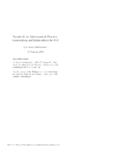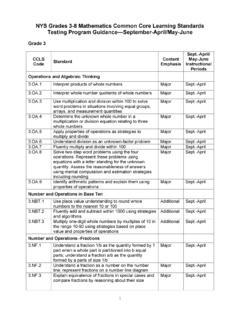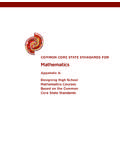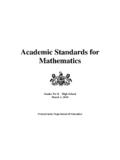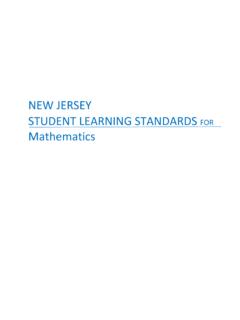Transcription of Progressions for the Common Core State Standards in ...
1 Progressions for the Common core State Standards in mathematics (draft). c The Common core Standards Writing Team 6 March 2015. Suggested citation: Common core Standards Writing Team. (2015, March 6). Progressions for the Common core State Stan- dards in mathematics (draft). Grades K 5, Number and Operations in Base Ten. Tucson, AZ: Institute for mathematics and Education, University of Arizona. For updates and more information about the Progres- sions, see For discussion of the Progressions and related top- ics, see the Tools for the Common core blog: http: Draft, 6 March 2015, comment at Number and Operations in Base Ten, K 5. Overview Students' work in the base-ten system is intertwined with their work on counting and cardinality, and with the meanings and properties of addition, subtraction, multiplication, and division. Work in the base-ten system relies on these meanings and properties, but also contributes to deepening students' understanding of them.
2 Position The base-ten system is a remarkably efficient and uni- form system for systematically representing all numbers. Using only the ten digits 0, 1, 2, 3, 4, 5, 6, 7, 8, 9, every number can be repre- sented as a string of digits, where each digit represents a value that depends on its place in the string. The relationship between values represented by the places in the base-ten system is the same for whole numbers and decimals: the value represented by each place is always 10 times the value represented by the place to its imme- diate right. In other words, moving one place to the left, the value of the place is multiplied by 10. In moving one place to the right, the value of the place is divided by 10. Because of this uniformity, standard algorithms for computations within the base-ten system for whole numbers extend to decimals. Base-ten units Each place of a base-ten numeral represents a base-ten unit: ones, tens, tenths, hundreds, hundredths, etc.
3 The digit in the place represents 0 to 9 of those units. Because ten like units make a unit of the next highest value, only ten digits are needed to represent any quantity in base ten. The basic unit is a one (represented by the rightmost place for whole numbers). In learning about whole numbers, children learn that ten ones com- pose a new kind of unit called a ten. They understand two-digit numbers as composed of tens and ones, and use this understanding in computations, decomposing 1 ten into 10 ones and composing a ten from 10 ones. The power of the base-ten system is in repeated bundling by ten: 10 tens make a unit called a hundred. Repeating this process of creating new units by bundling in groups of ten creates units called Draft, 6 March 2015, comment at NBT, K 5 3. thousand, ten thousand, hundred thousand .. In learning about decimals, children partition a one into 10 equal-sized smaller units, From the Standards glossary: each of which is a tenth.
4 Each base-ten unit can be understood in Computation algorithm. A set of predefined terms of any other base-ten unit. For example, one hundred can be steps applicable to a class of problems that gives viewed as a tenth of a thousand, 10 tens, 100 ones, or 1,000 tenths. the correct result in every case when the steps are carried out correctly. See also: computation strat- Algorithms for operations in base ten draw on such relationships egy. among the base-ten units. In mathematics , an algorithm is defined by its steps and not by the way those steps are recorded in writing. This progression gives Computations Standard algorithms for base-ten computations with examples of different recording methods and discusses their ad- vantages and disadvantages. the four operations rely on decomposing numbers written in base- ten notation into base-ten units. The properties of operations then The Standards do not specify a particular standard algorithm for each operation.
5 This progression gives examples of algorithms allow any multi-digit computation to be reduced to a collection of that could serve as the standard algorithm and discusses their single-digit computations. These single-digit computations some- advantages and disadvantages. times require the composition or decomposition of a base-ten unit. Add and subtract within 20, demonstrating fluency for addi- Beginning in Kindergarten, the requisite abilities develop grad- tion and subtraction within 10. Use strategies such as counting ually over the grades. Experience with addition and subtraction on; making ten ( , 8 ` 6 8 ` 2 ` 4 10 ` 4 14); decom- within 20 is a Grade 1 and fluency is a Grade 2 posing a number leading to a ten ( , 13 4 13 3 1 . Computations within 20 that cross 10, such as 9 ` 8 10 1 9); using the relationship between addition and subtrac- tion ( , knowing that 8 ` 4 12, one knows 12 8 4); and or 13 6, are especially relevant to NBT because they afford the creating equivalent but easier or known sums ( , adding 6 ` 7.)
6 Development of the Level 3 make-a-ten strategies for addition and by creating the known equivalent 6 ` 6 ` 1 12 ` 1 13). subtraction described in the OA progression . From the NBT per- Fluently add and subtract within 20 using mental strate- spective, make-a-ten strategies are (implicitly) the first instances of By end of Grade 2, know from memory all sums of two composing or decomposing a base-ten unit. Such strategies are a one-digit numbers. foundation for understanding in Grade 1 that addition may require Add within 100, including adding a two-digit number and a composing a and in Grade 2 that subtraction may involve one-digit number, and adding a two-digit number and a multiple decomposing a of 10, using concrete models or drawings and strategies based on place value, properties of operations, and/or the relationship between addition and subtraction; relate the strategy to a writ- Strategies and algorithms The Standards distinguish strategies ten method and explain the reasoning used.
7 Understand that from algorithms. Work with computation begins with use of strate- in adding two-digit numbers, one adds tens and tens, ones and gies and efficient, accurate, and generalizable methods. (See Grade ones; and sometimes it is necessary to compose a ten. 1 critical areas 1 and 2, Grade 2 critical area 2; Grade 4 critical area Add and subtract within 1000, using concrete models or 1.) For each operation, the culmination of this work is signaled in drawings and strategies based on place value, properties of op- the Standards by use of the term standard algorithm. erations, and/or the relationship between addition and subtrac- tion; relate the strategy to a written method. Understand that Initially, students compute using concrete models or drawings in adding or subtracting three-digit numbers, one adds or sub- and strategies based on place value, properties of operations, and/or tracts hundreds and hundreds, tens and tens, ones and ones.
8 The relationship between addition and subtraction (or multiplication and sometimes it is necessary to compose or decompose tens or and division). They relate their strategies to written methods and hundreds. explain the reasoning used (for addition within 100 in Grade 1; for From the Standards glossary: addition and subtraction within 1000 in Grade 2) or illustrate and Computation strategy. Purposeful manipula- tions that may be chosen for specific problems, explain their calculations with equations, rectangular arrays, and/or may not have a fixed order, and may be aimed area models (for multiplication and division in Grade 4). at converting one problem into another. See also: Students' initial experiences with computation also include de- computation algorithm. velopment, discussion, and use of efficient, accurate, and general- Examples of computation strategies are given in this progression izable methods.
9 So from the beginning, students see, discuss, and and in the Operations and Algebraic Thinking progression . explain methods that can be generalized to all numbers represented in the base-ten system. Initially, they may use written methods that include extra helping steps to record the underlying reasoning. These helping step variations can be important initially for under- Draft, 6 March 2015, comment at NBT, K 5 4. standing. Over time, these methods can and should be abbreviated into shorter written methods compatible with fluent use of standard algorithms. Students may also develop and discuss mental or written cal- culation methods that cannot be generalized to all numbers or are less efficient than other methods. Mathematical practices The Standards for Mathematical Practice are central in supporting students' progression from understanding and use of strategies to fluency with standard algorithms.
10 The ini- tial focus in the Standards on understanding and explaining such calculations, with the support of visual models, affords opportunities for students to see mathematical structure as accessible, important, interesting, and useful. Students learn to see a number as composed of its base-ten units ( ). They learn to use this structure and the properties of op- erations to reduce computing a multi-digit sum, difference, product, or quotient to a collection of single-digit computations in different base-ten units. (In some cases, the Standards refer to multi-digit . operations rather than specifying numbers of digits. The intent is that sufficiently many digits should be used to reveal the standard algorithm for each operation in all its generality.) Repeated reason- Uniformity of the base-ten system ing ( ) that draws on the uniformity of the base-ten system is a 10 10 10. part of this process.






